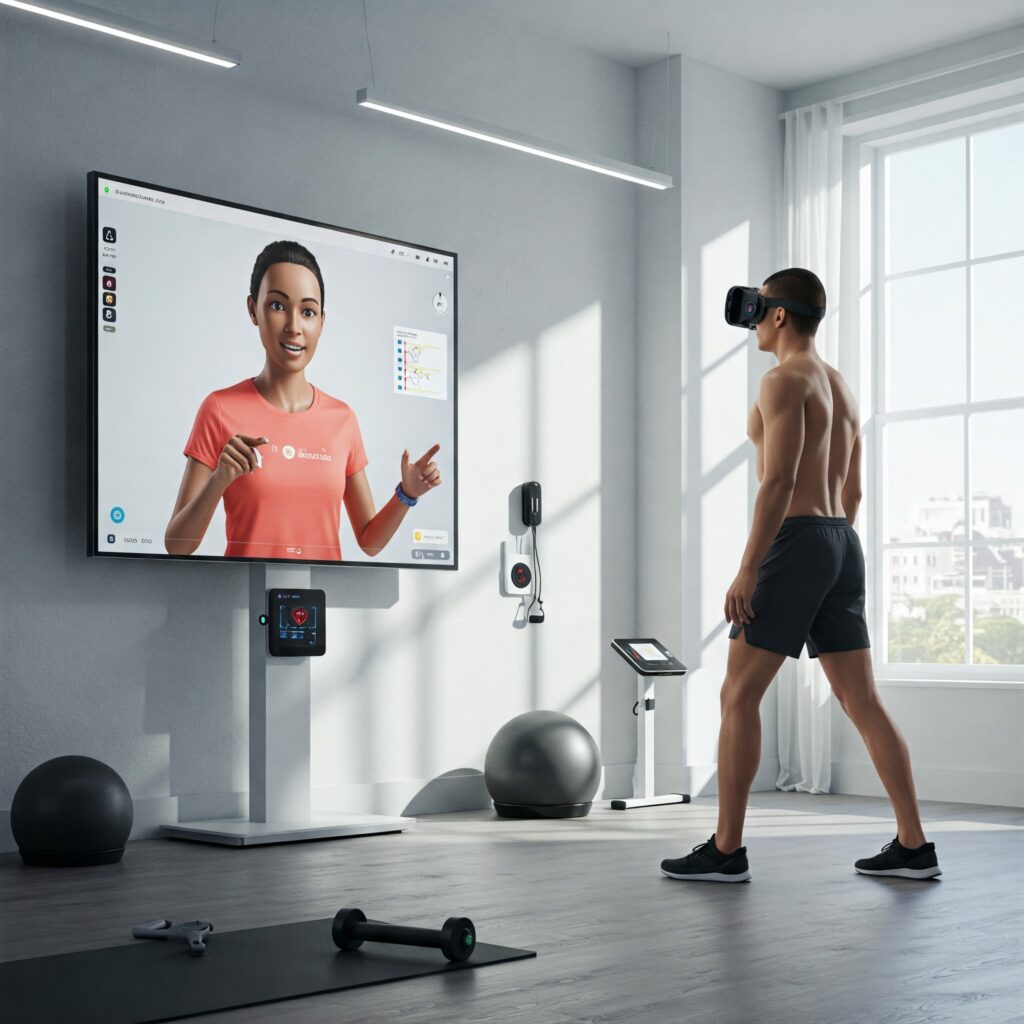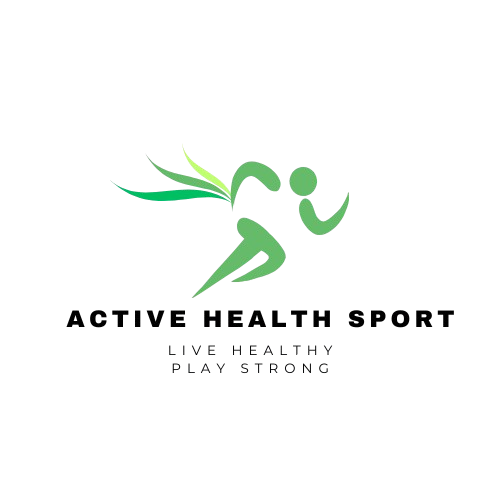Artificial Intelligence (AI) has revolutionized countless industries, and sports coaching is no exception. AI coaching is changing how athletes train, compete, and achieve peak performance. In this blog, we will dive into the transformative impact of AI coaching on sports and fitness, exploring how this technology enhances personalized training, performance analysis, and injury prevention. Let’s stay with us!
What is AI Coaching in 2025?
AI coaching is the integration of artificial intelligence into sports, fitness, and personal training programs, revolutionizing how athletes and individuals achieve their goals. Whether it’s analyzing running techniques, suggesting optimal recovery strategies, or identifying areas for improvement, AI coaching acts like a virtual assistant, ensuring precision and efficiency in training.
It empowers athletes to adapt their programs dynamically, addressing specific strengths, weaknesses, and progress over time. At Active Health Sport, we recognize that innovations like AI coaching are transformative tools reshaping the future of sports and fitness.
Embracing this technology, athletes and fitness enthusiasts can maximize their potential, enhance performance, and achieve goals with smarter, data-driven strategies. It’s a leap forward in making professional-level coaching accessible to everyone, from beginners to elite competitors.
The Benefits of AI Coaching in Sports
AI coaching has opened new avenues for both professional athletes and fitness enthusiasts. Let’s explore the primary benefits it brings:
1. Personalized Training Programs
Traditional training plans often follow a one-size-fits-all practice. However, every athlete is unique, with distinct strengths, weaknesses, and goals. AI coaching leverages data to create tailored training regimens that cater to individual requirements.
For instance, AI systems can monitor heart rate, speed, endurance, and recovery times to adjust workout plans in real time.
2. Advanced Performance Analysis
Gone are the days of relying solely on a coach’s observational skills. AI coaching tools can analyze an athlete’s movements, biomechanics, and efficiency in minute detail.
Key Features of AI Performance Analysis:
- Video motion tracking to identify improper posture.
- Real-time feedback on technique during drills or exercises.
- Detailed reports comparing performance metrics over time.
3. Injury Prevention
Injuries are among the most significant setbacks an athlete can face, often leading to long recovery periods and lost opportunities. AI coaching has emerged as a powerful tool for minimizing these risks by proactively identifying and addressing potential issues before they escalate.
With advanced algorithms and real-time data analysis, AI systems are transforming the way athletes approach injury prevention.
Analyzing Movement Patterns
AI coaching platforms use motion sensors, wearable devices, and video analysis to track an athlete’s movements in detail. These systems can:
- Detect improper techniques during exercises such as squats, deadlifts, or running.
- Identify asymmetrical movement patterns that might indicate muscular imbalances or weaknesses.
- Provide actionable insights to correct form and reduce unnecessary strain on joints and muscles.
For instance, a runner might unknowingly land with excessive force on one leg, increasing the risk of knee injuries. An AI system can alert the athlete and recommend drills or exercises to correct this imbalance.

Monitoring Physical Stress Levels
One of the unique advantages of AI coaching is its ability to assess physical stress and fatigue through continuous monitoring. Tools such as heart rate variability (HRV) trackers and load-monitoring algorithms can determine whether an athlete is overtraining. These insights allow:
- Early Detection: Recognizing signs of excessive strain before they manifest as injuries.
- Recovery Optimization: Suggesting rest periods or alternative workouts to promote recovery and prevent burnout.
- Customized Workouts: Tailoring routines to match the athlete’s current physical condition, ensuring a balance between challenge and safety.
For example, AI might recommend lighter training days or alternative activities like swimming or yoga if stress indicators exceed safe levels.
Also Read the Latest: How Morning Stretches Can Boost Your Productivity (GUIDE)
How Does Prevention Make an Impact on Team Sports?
In team sports, where players face grueling schedules with intense practices and frequent games, injury prevention is particularly critical. AI coaching provides several benefits in this context:
- Load Management: By monitoring individual players’ workloads, coaches can adjust training intensity to minimize fatigue-related injuries.
- Player Comparisons: AI systems can analyze data across the team to identify outlier players who may be at higher risk due to overuse or insufficient conditioning.
- Real-Time Alerts: During games or training, AI tools can flag abnormal movements or signs of physical distress, allowing for immediate intervention.
Role in Rehabilitation
AI coaching extends its benefits to injury recovery, making it an invaluable resource for athletes returning to play. By tracking rehabilitation progress, AI can:
- Ensure adherence to prescribed exercises.
- Gradually increase training intensity based on real-time feedback.
- Prevent re-injury by highlighting unsafe movements or premature increases in workload.
For instance, an athlete recovering from a shoulder injury might use an AI-powered app to monitor their range of motion and strength, ensuring steady and safe progress.
How Can AI Coaching Help Reduce Common Sports Injuries?
AI coaching plays a pivotal role in minimizing the risk of common sports injuries such as sprains, strains, and tendonitis. By using data-driven insights, AI tools provide athletes with personalized strategies to protect their bodies and maintain peak performance. Here’s how:
- AI analyzes your body type, sport, and physical condition to recommend specific warm-up and stretching exercises. For instance, soccer players might receive stretches targeting hamstrings and quads, while swimmers focus on shoulder flexibility.
- AI identifies weak points in the body and suggests exercises to fortify them. Basketball players might work on ankle stability, while weightlifters focus on lower back strength to prevent injuries during heavy lifts.
- AI tools offer insights into optimizing your gear, such as selecting the right footwear for running or adjusting a racket grip in tennis. These adjustments reduce undue stress and improve biomechanics.
- Through wearable devices, AI tracks your movement during workouts and flags improper techniques that could lead to injuries. For example, it can alert you if your knee alignment is off during squats or if your running stride is putting excessive strain on your joints.
- By analyzing performance metrics over time, AI can suggest when to rest or recover, helping you avoid overtraining-related injuries like tendonitis or stress fractures.
Empowering Athletes with Knowledge
This technology provides in-depth insights and personalized recommendations that empower athletes to take proactive control of their fitness journey. Here’s how:
- Understanding Physical Limits: AI coaching delivers data-driven analysis, helping athletes recognize their physical boundaries and how to safely push beyond them. For instance, a runner might learn the optimal pace to reduce fatigue without risking injury, or a weightlifter might understand when to increase load safely.
- Building Sustainable Habits: Personalized feedback educates athletes on proper form, recovery strategies, and conditioning exercises. Over time, this fosters habits that enhance long-term health, such as maintaining correct posture during repetitive movements or integrating mobility exercises into daily routines.
- Developing a Proactive Mindset: With detailed performance reports, athletes shift from reactive responses to injuries toward a preventive approach. Instead of waiting for signs of overuse or strain, they’re equipped to make adjustments, whether it’s resting a specific muscle group, modifying training intensity, or incorporating new recovery techniques.
- Access to Tailored Knowledge: AI-generated recommendations aren’t generic; they’re customized based on sport, age, physical condition, and goals. For example, a basketball player may learn how to minimize knee strain during jumps, while a cyclist may receive tips on improving spinal alignment to prevent back pain.
AI coaching allows athletes to bridge the gap between potential and performance. When athletes understand their bodies better, they can train smarter, recover efficiently, and stay committed to their long-term goals without the fear of setbacks.
Enhanced Decision-Making for Coaches and Athletes
AI coaching tools have revolutionized the way coaches and athletes make critical decisions in training and competition. These tools go beyond what the human eye can observe, offering granular insights into performance, fatigue levels, and strategic opportunities.
Coaches can use these insights to make smarter substitutions, fine-tune game strategies, or identify specific areas where an athlete needs improvement. For example, in soccer, AI systems can monitor players’ exertion levels and predict fatigue, enabling coaches to substitute players before their performance declines significantly.
Additionally, AI tools assist in optimizing training schedules by identifying patterns that might lead to overtraining or underperformance. For instance, a basketball coach might use AI to track shooting accuracy trends during practices and games. If data reveals a player’s accuracy drops toward the end of the game, adjustments can be made to their conditioning routine or rotation to maintain peak performance when it matters most.
Example: A soccer coach might use AI data to determine which players are showing signs of fatigue and need rest during a game.
Example 2: Another example is in tennis, where AI can analyze a player’s biomechanics and match statistics to recommend adjustments in serving techniques or shot selection. If an athlete’s data shows a decline in their second-serve success rate during high-pressure points, a coach can design drills to target this weakness, helping the player build confidence and consistency.
How AI Coaching is Shaping the Future of Sports?
AI coaching is revolutionizing sports by delivering real-time performance analysis, injury prevention strategies, and personalized training plans. By leveraging data analytics, machine learning, and advanced algorithms, AI empowers athletes to optimize their skills and coaches to make data-driven decisions.
1. Virtual Coaches for Remote Training
AI coaching has made professional guidance accessible to anyone with an internet connection. Virtual coaches powered by AI provide users with training tips, corrective feedback, and encouragement all from the comfort of their homes.
2. Gamification of Training
AI coaching apps often incorporate gamified elements to keep users motivated. Features like leaderboards, achievement badges, and progress tracking turn workouts into an engaging experience.
Why Gamification Works:
- It encourages consistency.
- Makes training sessions fun and interactive.
- Provides tangible rewards for meeting fitness goals.
3. Data-Driven Strategies in Professional Sports
Professional teams are increasingly relying on AI-driven analytics for game strategies. By analyzing opponents’ patterns, strengths, and weaknesses, AI provides valuable insights that can give teams a competitive edge.
Example: AI systems can identify a basketball opponent’s tendencies to shoot from certain zones, enabling teams to adjust their defense accordingly.
Also Read the Latest: How🥽Virtual Reality is Revolutionizing Sports Training (2025)

What are the Challenges in Implementing AI Coaching?
While AI coaching offers transformative benefits, its adoption is not without challenges. Understanding and addressing these hurdles is crucial for maximizing its potential and ensuring it serves the diverse needs of athletes and fitness enthusiasts effectively.
1. High Initial Costs
Developing and implementing AI systems involves substantial investment in hardware, software, and training personnel to use the technology effectively. For instance:
- Small fitness centers or independent coaches may struggle to afford cutting-edge AI systems.
- Continuous updates and maintenance of AI systems can add to the financial burden over time.
Despite these challenges, as AI becomes more widespread, the costs are expected to decrease, making it more accessible to smaller organizations and individuals. Affordable subscription-based AI platforms are beginning to bridge this gap, but more work is needed to democratize the technology.
2. Data Privacy Concerns
AI coaching systems rely on vast amounts of user data, including personal health metrics, movement patterns, and even biometric information. This raises concerns about:
- Data Security: Unauthorized access to sensitive information can lead to privacy breaches.
- Ownership: Athletes may question who owns their data, the individual, or the AI service provider.
- Compliance: Meeting regional and international data privacy regulations like GDPR (General Data Protection Regulation) or HIPAA (Health Insurance Portability and Accountability Act) adds complexity.
To mitigate these concerns, companies developing AI coaching tools must prioritize transparency and data security. Encryption, anonymization of data, and user consent are critical components of responsible AI implementation.
3. Dependence on Technology
While AI coaching offers numerous advantages, over-reliance on technology can pose risks:
- Loss of Human Touch: Emotional support, encouragement, and a deep understanding of an athlete’s mindset are vital aspects of coaching that AI cannot fully replicate.
- Technical Failures: AI systems are not immune to glitches or malfunctions, which could disrupt training programs or provide inaccurate feedback.
- Skill Erosion: Coaches and athletes may become overly dependent on AI tools, potentially neglecting the development of their observational and analytical skills.
Balancing AI with human coaching ensures that technology complements rather than replaces the expertise and intuition of human trainers.
4. Lack of Standardization
The AI coaching market is still evolving, and a lack of standardization can lead to inconsistencies:
- Different AI platforms may provide conflicting advice based on varying algorithms and datasets.
- There is no universal metric to evaluate the effectiveness of AI coaching tools, making it challenging to choose the best option.
Developing industry-wide standards and best practices could help address these issues and ensure consistency and reliability across AI coaching platforms.
5. Resistance to Change
Adopting AI in coaching often requires a shift in mindset among athletes, coaches, and organizations:
- Traditional coaches may view AI as a threat to their role and expertise.
- Athletes accustomed to conventional training methods may be hesitant to trust AI-based feedback.
Educational initiatives and demonstrations of AI’s effectiveness can help overcome this resistance. Highlighting how AI enhances, rather than replaces, human coaching can foster greater acceptance.
6. Limited Accessibility in Developing Regions
AI coaching is predominantly available in developed countries with advanced technological infrastructure. Athletes and coaches in developing regions may face:
- Limited access to reliable internet connections or devices needed to utilize AI tools.
- Financial constraints make even affordable AI systems inaccessible.
Addressing these disparities requires a global effort to make AI tools more affordable and accessible while improving digital infrastructure in underserved areas.
7. Potential for Bias in AI Algorithms
AI systems are only as good as the data they are trained on. Biases in training data can result in AI tools that:
- Favor certain body types or demographics.
- Provide less accurate feedback for underrepresented groups in sports science research.
Developers must actively work to identify and eliminate biases during the development process, ensuring that AI coaching tools serve a diverse population of users equitably.
Overcoming the Challenges of AI Coaching
The challenges in implementing AI coaching are not insurmountable. With strategic planning, innovation, and collaboration, these obstacles can be addressed effectively.
- Collaboration Between Experts: Combining the expertise of sports scientists, technologists, and professional coaches can lead to AI systems that are accurate, reliable, and user-friendly.
- Investment in Research and Development: Continuous investment in AI research will drive innovation and cost reductions, making the technology more accessible.
- Focus on Ethics and Regulation: Establishing ethical guidelines and regulatory frameworks ensures that AI coaching systems are developed and used responsibly.
- Hybrid Coaching Models: Integrating AI with traditional coaching methods combines the best of both worlds, ensuring that the human element remains a core component of training.
AI Coaching at Active Health Sport
At Active Health Sport, we strive to stay at the forefront of innovation in sports training. Our mission is to empower athletes and fitness enthusiasts with tools and knowledge that help them reach new heights.
AI coaching aligns perfectly with our vision, combining advanced technology with a commitment to excellence. Whether you’re an amateur looking to start your fitness journey or a professional aiming for peak performance, our resources will guide you every step of the way.
Closing Thoughts
AI coaching is a transformative force in the sports and fitness industry. It helps athletes push boundaries, achieve peak performance, and reduce injury risks. It also equips coaches with data-driven tools to make smarter decisions, optimizing team strategies and individual development.
While hurdles like cost and data privacy require attention, the benefits of AI coaching far outweigh the challenges. It fosters a deeper understanding of performance metrics, encourages smarter training habits, and creates opportunities for athletes of all levels to reach their full potential.
At Active Health Sport, we are committed to helping athletes embrace innovation. With the right combination of technology and dedication, achieving your fitness goals becomes more attainable than ever. That’s all for today, guys! If you have any questions in your mind, feel free to comment below or email us your queries; we are happy to respond to you.
You might also like…
- Why a Digital Detox Before Bed Can Fix Your Sleep Faster
 The Modern Sleep Thief Hiding in Your Hand In a world where we check our phones hundreds of times a day, it’s no surprise our sleep has taken a hit.Most… Read more: Why a Digital Detox Before Bed Can Fix Your Sleep Faster
The Modern Sleep Thief Hiding in Your Hand In a world where we check our phones hundreds of times a day, it’s no surprise our sleep has taken a hit.Most… Read more: Why a Digital Detox Before Bed Can Fix Your Sleep Faster - How to Align Your Circadian Rhythm for All-Day Energy Gains
 Why You Feel Tired Even After Sleeping Enough Have you ever slept for eight hours and still felt groggy the next morning?The issue might not be how long you sleep,… Read more: How to Align Your Circadian Rhythm for All-Day Energy Gains
Why You Feel Tired Even After Sleeping Enough Have you ever slept for eight hours and still felt groggy the next morning?The issue might not be how long you sleep,… Read more: How to Align Your Circadian Rhythm for All-Day Energy Gains - Electrolytes vs. Water: What Active Adults Must Know
 Beyond Water, The Hidden Key to True Hydration Most adults know the rule, “Drink more water.”But few realize that hydration isn’t just about fluid intake. It’s about electrolyte balance, the… Read more: Electrolytes vs. Water: What Active Adults Must Know
Beyond Water, The Hidden Key to True Hydration Most adults know the rule, “Drink more water.”But few realize that hydration isn’t just about fluid intake. It’s about electrolyte balance, the… Read more: Electrolytes vs. Water: What Active Adults Must Know

Kait Amazra is the founder and lead writer of Active Health Sport. With over 25 years of experience in health, fitness, and wellness education, Kait combines professional expertise with a passion for helping people live stronger, healthier, and more balanced lives.
As a licensed health and fitness professional, Kait has worked alongside industry experts to deliver evidence-based insights on physical activity, nutrition, recovery, and holistic well-being. Through Active Health Sport, Kait’s mission is to make trusted, practical, and science-backed health information accessible to everyone, from beginners building new habits to athletes seeking peak performance.


Very good content, thank you for providing these insights.